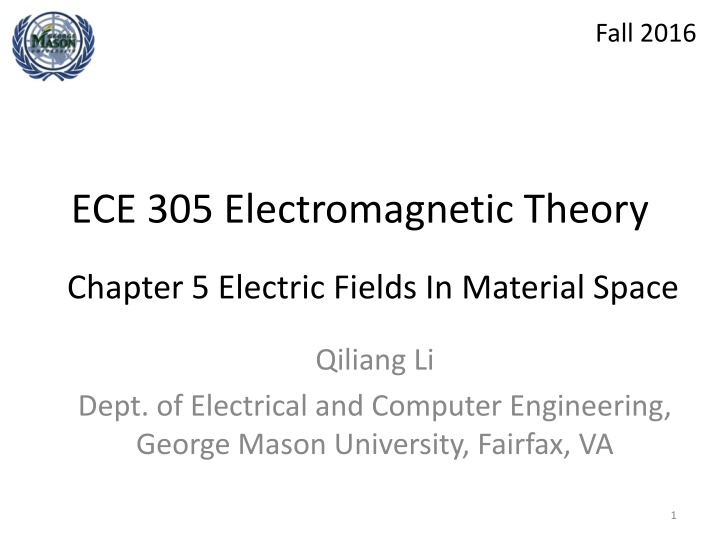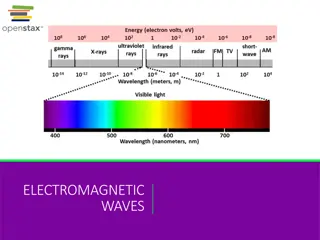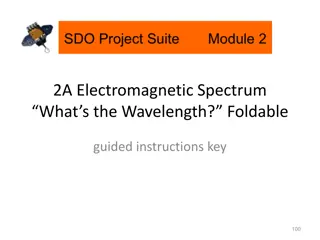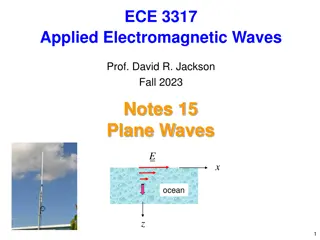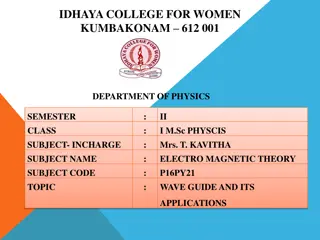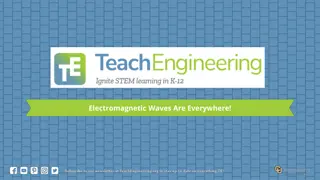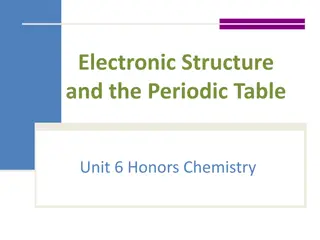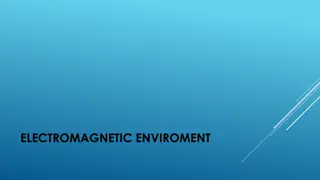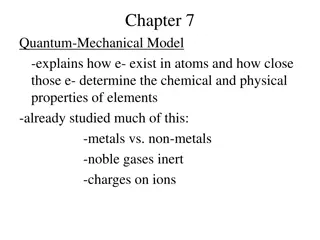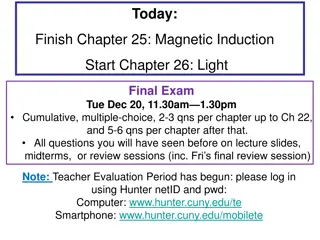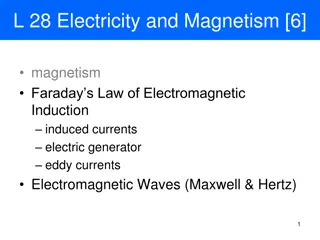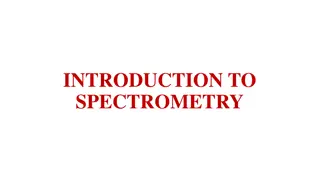ECE 305 Electromagnetic Theory
Explore the fundamental concepts of electric fields in material space, covering topics such as free space, conductors, insulators, semiconductors, current conduction, and charge density. Delve into the properties of materials, convection vs. conduction current, and the role of superconductors in electromagnetic theory.
Download Presentation

Please find below an Image/Link to download the presentation.
The content on the website is provided AS IS for your information and personal use only. It may not be sold, licensed, or shared on other websites without obtaining consent from the author.If you encounter any issues during the download, it is possible that the publisher has removed the file from their server.
You are allowed to download the files provided on this website for personal or commercial use, subject to the condition that they are used lawfully. All files are the property of their respective owners.
The content on the website is provided AS IS for your information and personal use only. It may not be sold, licensed, or shared on other websites without obtaining consent from the author.
E N D
Presentation Transcript
Fall 2016 ECE 305 Electromagnetic Theory Chapter 5 Electric Fields In Material Space Qiliang Li Dept. of Electrical and Computer Engineering, George Mason University, Fairfax, VA 1
5.1 Introduction Free Space / Vacuum: 0 conductors Real material space nonconductors Nonconductors insulators or dielectrics Susceptibility, permittivity, linearity, isotropy, homogeneity, dielectric strength, and relaxation time 2
5.2 Properties of Materials Conductivity, unit: Siemens per meter ( S/m ) metals: >> 1 Insulators: << 1 in between Semiconductors As T 0K, some conductors have Called: superconductors What is Semiconductor ? 3
Examples MOSFET conductor Semiconductor Optical fiber 4
5.3 Convection and Conduction Current The current (in amperes) through a given area is the electric charge passing through the area per unit time. 1 A = 1 C/s ? =?? ?? ? ? or ? = ? ?? Current density ? = 5
Different between convection current and conduction current Convection current does not involve conductors, therefore, does not satisfy Ohm s law. It occurs when current flows through an insulating medium such as liquid, rarefied gas or a vacuum 6
S V (charge density) z y y x ? = ? ?=?? ? =?? ? ? = ?? ? ?? ? ? ??= ? ?= ???? 7
In general: ? = ??? So, this equation is the general form of both convection and conduction current density For conduction current, ??can be expressed by electron density see next page 8
Conduction current requires a conductor ? = ?? From momentum Ft = mu: ?? ? : the average time interval between collisions electron travel in a real materials space = ?? e 9
Therefore, ? = ?? ?? If there are n electrons per unit volume ??= ?? So ? = ??? =??2? ? ? or ? = ?? 10
5.4 Conductors A perfect conductor (? = ) cannot contain E-field within it. Ee V=0 Ei Ee E=0 Ee is applied external field, Ei is internal field --isolated conductor: V= constant 11
For a conductor whose ends are maintained at potential difference V ? 0 inside the conductor ? =? ? =? ? ?= ?? = ?? ? ?? or ? =??? ? ? ?= ?? Where c = 1/ is the resistivity ? ? =? ?= ? 12
For a conductor with nonuniform cross section ?? ?? ? =? ?= ??? ?? Power P (in watts): rate of change of energy W (in Joules) ? = ???? ? ? = ? ????? = ? ??? ? ? 13
Power density wP (in W/m3) ??=?? ??= ? ? = ?|?|2 For a conductor with uniform cross-section ? = ? ?? ? ?? = ?? ? ? ? = ?2? --- the common Or form of Joule s law 14
1 ?32??????+ ?????? ?/?2 Example 5.1: If ? = Calculate the current passing through (a)A hemispherical shell of radius = 20 cm, 0 < ? <? 2;0 < ? < 2? ? = ?? ?? Solve: where ?? = ?2?????????? ? 2 0 4? 0.2 2 2? 1 ?32???? ?2????????|?=0.2= ( from 0 to /2)=31.4 (A) ? = 0 ???2? So 15
Continue example 5.1 (b) A spherical shell of radius 10 cm ? =4? 0.1 Example 5.4: A lead (? = 5 106 ?/?) bar of square cross section has a circular hole. L=4 m Find the resistance. Solve: ? = ?/?? b/c: ? = ?2 ??2 ???2? 2 ( from 0 to )=0 1 cm 4 So, ? = 5 106 9 ? 4 10 4 3 cm 16
5.5 Polarization in Dielectrics Dipole moment p= ?? ? ?=1 ???? ? Polarization in dielectrics ? = lim ? 0 This is dipole moment per unit volume So, potential ?? =? ???? 4??0?2 where P dV is the dipole moment (dV is diff vol.) 1 ? ?2 ? ?? ?2= ? =?? b/c: ? ? ? ? ? So ? 17
?? 4??0??? ? ?? 4??0??? + ? Therefore, ? = ? Compared to Eq. (4.68) and (4.69) The total positive bound charges on surface S: ??= ? ?? The charge that remains inside S is ??= ? ??? ? Total volume charge density t: ??= ??+ ???= ? ?0? 18
Therefore, ??= ? ?0? ???= ? (?0? + ?) From this equation, we have:? = (?0? + ?) For some dielectrics, ? = ???0? where Xe is electric susceptibility 19
5.6 Dielectric Constant and Strength ? = ?01 + ??? = ?0??? Or ? = ?0??? = ?? where ? = ?0??, the permittivity ? ?0 ?? is the dielectric constant: ??= 1 + ??= Dielectric strength is the maximum electric field that a dielectric can tolerate or withstand without electric breakdown. 20
5.7 is not required 5.8 Continuity equation and relaxation time ????= ? ?? = ???? ??? ???? = ?? ? ? ? = ??? ?? b/c: ? = ?? , and ? ? =?? ? So, ? ?? =??? = ??? ?? ??? ??= ? ??? ? So, ??= ??0? ?/??, where ??= ?/? 21
5.9 Boundary Conditions Use Maxwell s Equations ? ?? = 0 ?? ?? = ???? A. Dielectric-Dielectric Boundary Conditions Consider L: abcd 1 E1 E1n E1t h a b E2 d ? ?? = 0 2 E2n W c E2t 22
? ?? = 0 2 ?2? 2 ?2? ? + ?2? 2 = ?1? ? ?1? 2 ?1?= ?2? ?1? + ?1? ?1=?2? ?2 Use cylindrical Gaussian surface ? = ?? ? = ?1? ? ?2? ? ?1? ?2?= ?? If ??= 0 (no free surface charge), ?1?= ?2? 23
therefore, ?1?1?= ?2?2? From ?1?= ?2? and ?1?1?= ?2?2? ????1 ??2 ????2=??1 1 B. Conductor-Dielectric Boundary Conditions No electric field may exist within a conductor ??= 0 , b/c E = ?? = 0 there can be no potential difference between any two point in a conductor 2 ? = 0 24
??= ?0????= 0, ??= ?0????= ?? E-field must be external to the conductor C. Conductor-Free space boundary conditions ??= ?0??= 0, ??= ?0??= ?? Example 5.9 and 5.10 will discussed in the class. 25
